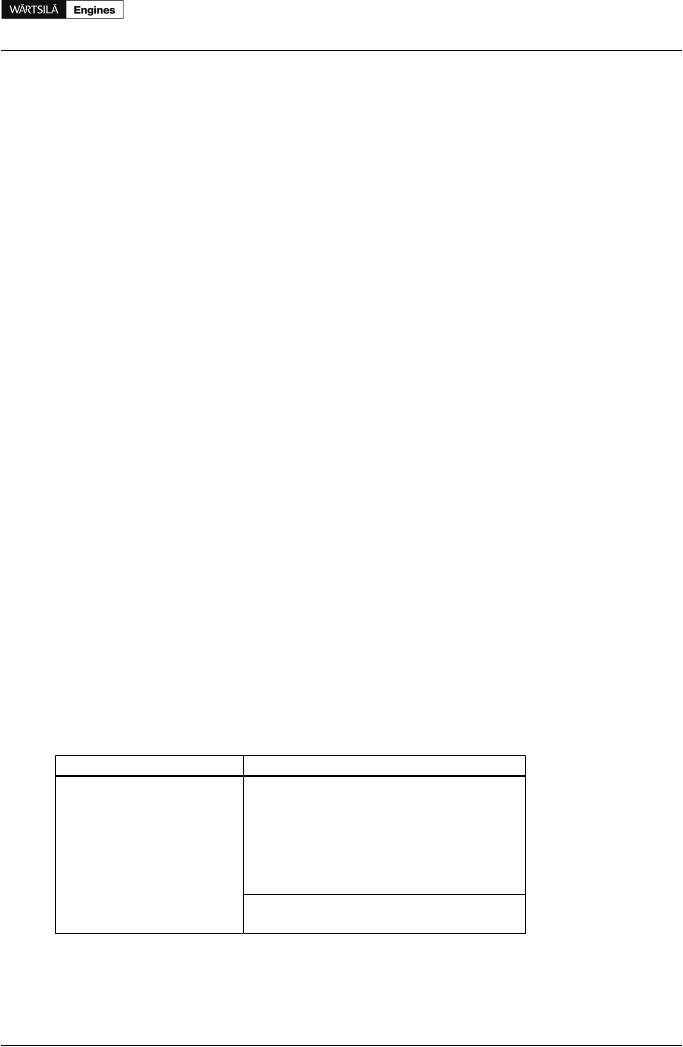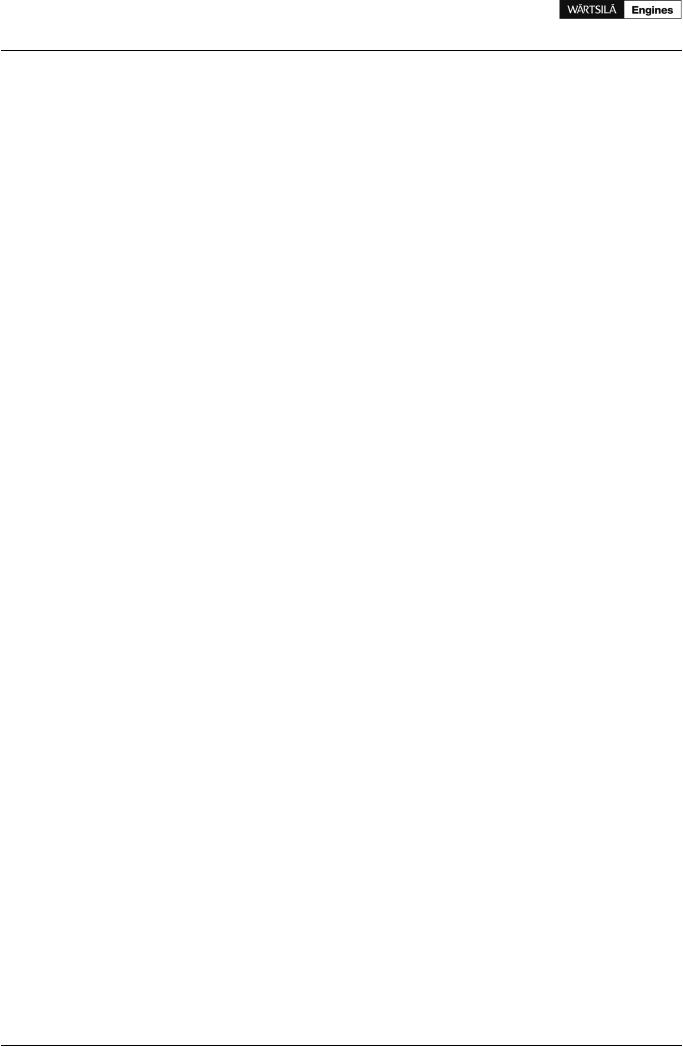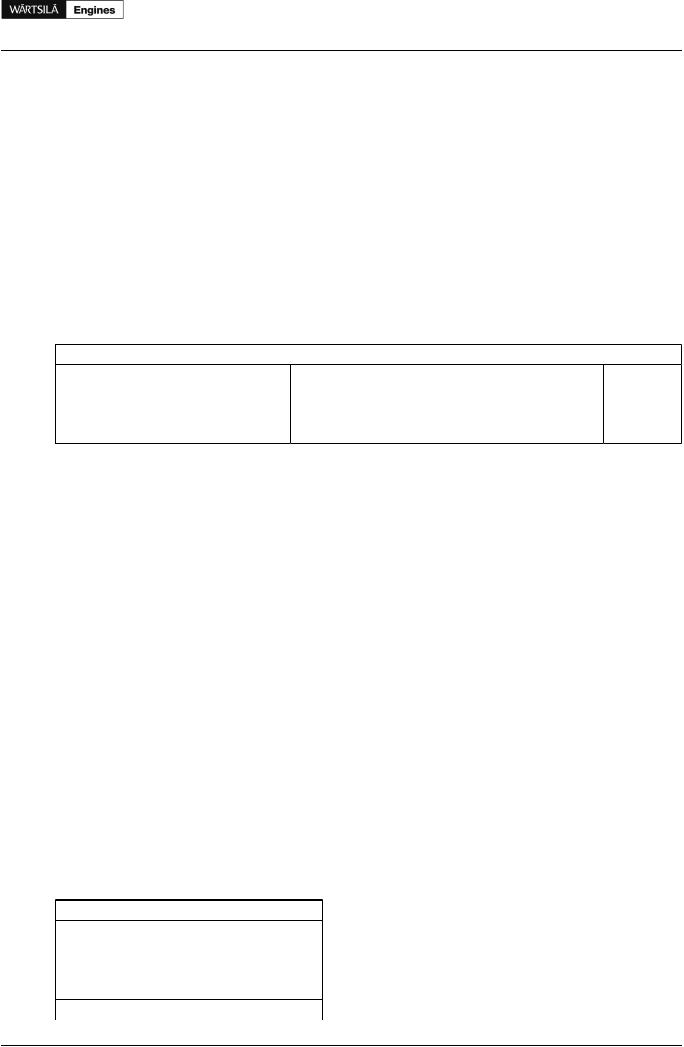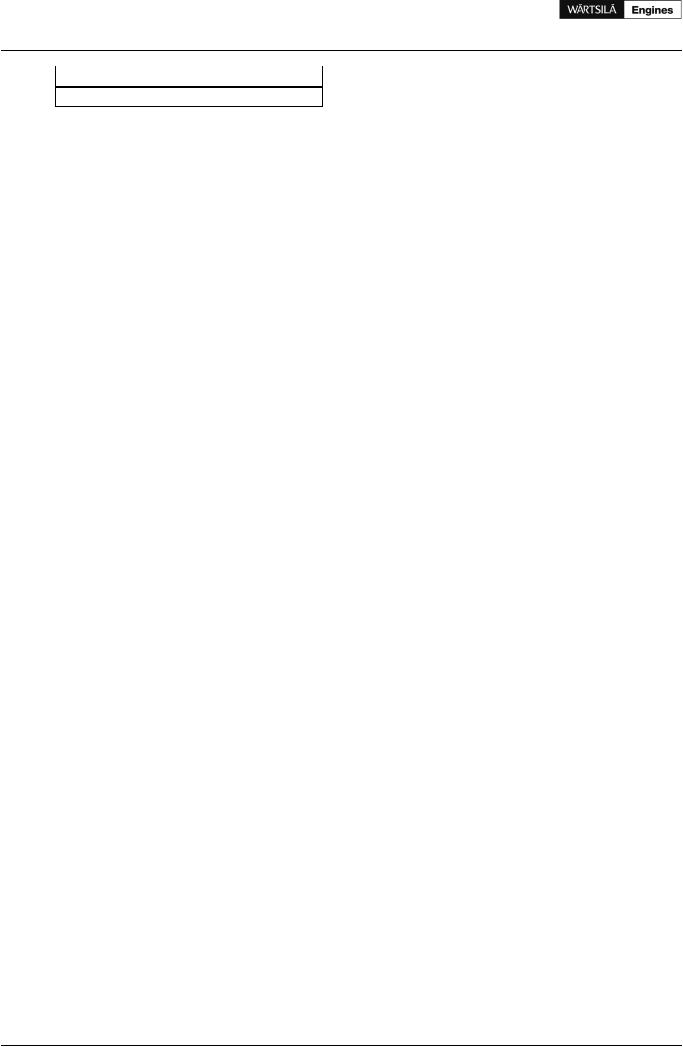
- •Introduction
- •Table of Contents
- •1. Main Data and Outputs
- •1.1 Maximum continuous output
- •1.2 Reference conditions
- •1.3 Operation in inclined position
- •1.4 Dimensions and weights
- •2. Operating ranges
- •2.1 Engine operating range
- •2.2 Loading capacity
- •2.3 Low air temperature
- •2.4 Operation at low load and idling
- •3. Technical Data
- •3.1 Wärtsilä 4L20
- •3.2 Wärtsilä 6L20
- •3.3 Wärtsilä 8L20
- •3.4 Wärtsilä 9L20
- •4. Description of the Engine
- •4.1 Definitions
- •4.2 Main components and systems
- •4.3 Cross sections of the engine
- •4.4 Overhaul intervals and expected lifetimes
- •5. Piping Design, Treatment and Installation
- •5.1 Pipe dimensions
- •5.2 Trace heating
- •5.3 Operating and design pressure
- •5.4 Pipe class
- •5.5 Insulation
- •5.6 Local gauges
- •5.7 Cleaning procedures
- •5.8 Flexible pipe connections
- •5.9 Clamping of pipes
- •6. Fuel Oil System
- •6.1 Acceptable fuel characteristics
- •6.2 Internal fuel oil system
- •6.3 External fuel oil system
- •7. Lubricating Oil System
- •7.1 Lubricating oil requirements
- •7.2 Internal lubricating oil system
- •7.3 External lubricating oil system
- •7.4 Crankcase ventilation system
- •7.5 Flushing instructions
- •8. Compressed Air System
- •8.1 Internal compressed air system
- •8.2 External compressed air system
- •9. Cooling Water System
- •9.1 Water quality
- •9.2 Internal cooling water system
- •9.3 External cooling water system
- •10. Combustion Air System
- •10.1 Engine room ventilation
- •10.2 Combustion air system design
- •11. Exhaust Gas System
- •11.1 Internal exhaust gas system
- •11.2 Exhaust gas outlet
- •11.3 External exhaust gas system
- •12. Turbocharger Cleaning
- •12.1 Turbine cleaning system
- •12.2 Compressor cleaning system
- •13. Exhaust Emissions
- •13.1 Diesel engine exhaust components
- •13.2 Marine exhaust emissions legislation
- •13.3 Methods to reduce exhaust emissions
- •14. Automation System
- •14.1 UNIC C1
- •14.2 UNIC C2
- •14.3 Functions
- •14.4 Alarm and monitoring signals
- •14.5 Electrical consumers
- •15. Foundation
- •15.1 Steel structure design
- •15.2 Mounting of main engines
- •15.3 Mounting of generating sets
- •15.4 Flexible pipe connections
- •16. Vibration and Noise
- •16.1 External forces and couples
- •16.2 Mass moments of inertia
- •16.3 Structure borne noise
- •16.4 Air borne noise
- •17. Power Transmission
- •17.1 Flexible coupling
- •17.2 Clutch
- •17.3 Shaft locking device
- •17.4 Power-take-off from the free end
- •17.5 Input data for torsional vibration calculations
- •17.6 Turning gear
- •18. Engine Room Layout
- •18.1 Crankshaft distances
- •18.2 Space requirements for maintenance
- •18.3 Transportation and storage of spare parts and tools
- •18.4 Required deck area for service work
- •19. Transport Dimensions and Weights
- •19.1 Lifting of engines
- •19.2 Engine components
- •20. Product Guide Attachments
- •21. ANNEX
- •21.1 Unit conversion tables
- •21.2 Collection of drawing symbols used in drawings

Product Guide
5. Piping Design, Treatment and Installation
5.Piping Design, Treatment and Installation
This chapter provides general guidelines for the design, construction and installation of piping systems, however, not excluding other solutions of at least equal standard.
Fuel, lubricating oil, fresh water and compressed air piping is usually made in seamless carbon steel (DIN 2448) and seamless precision tubes in carbon or stainless steel (DIN 2391), exhaust gas piping in welded pipes of corten or carbon steel (DIN 2458). Pipes on the freshwater side of the cooling water system must not be galvanized. Sea-water piping should be made in hot dip galvanised steel, aluminium brass, cunifer or with rubber lined pipes.
Attention must be paid to fire risk aspects. Fuel supply and return lines shall be designed so that they can be fitted without tension. Flexible hoses must have an approval from the classification society. If flexible hoses are used in the compressed air system, a purge valve shall be fitted in front of the hose(s).
The following aspects shall be taken into consideration:
•Pockets shall be avoided. When not possible, drain plugs and air vents shall be installed
•Leak fuel drain pipes shall have continuous slope
•Vent pipes shall be continuously rising
•Flanged connections shall be used, cutting ring joints for precision tubes
Maintenance access and dismounting space of valves, coolers and other devices shall be taken into consideration. Flange connections and other joints shall be located so that dismounting of the equipment can be made with reasonable effort.
5.1Pipe dimensions
When selecting the pipe dimensions, take into account:
•The pipe material and its resistance to corrosion/erosion.
•Allowed pressure loss in the circuit vs delivery head of the pump.
•Required net positive suction head (NPSH) for pumps (suction lines).
•In small pipe sizes the max acceptable velocity is usually somewhat lower than in large pipes of equal length.
•The flow velocity should not be below 1 m/s in sea water piping due to increased risk of fouling and pitting.
•In open circuits the velocity in the suction pipe is typically about 2/3 of the velocity in the delivery pipe.
Recommended maximum fluid velocities on the delivery side of pumps are given as guidance in table 5.1.
Table 5.1 Recommended maximum velocities on pump delivery side for guidance
Piping |
Pipe material |
Max velocity [m/s] |
Fuel piping (MDF and HFO) |
Black steel |
1.0 |
Lubricating oil piping |
Black steel |
1.5 |
Fresh water piping |
Black steel |
2.5 |
Sea water piping |
Galvanized steel |
2.5 |
|
Aluminium brass |
2.5 |
|
10/90 copper-nickel-iron |
3.0 |
|
70/30 copper-nickel |
4.5 |
|
Rubber lined pipes |
4.5 |
NOTE! The diameter of gas fuel piping depends only on the allowed pressure loss in the piping, which has to be calculated project specifically.
Product Guide Wärtsilä 20 - 3/2009 |
23 |

Product Guide
5. Piping Design, Treatment and Installation
Compressed air pipe sizing has to be calculated project specifically. The pipe sizes may be chosen on the basis of air velocity or pressure drop. In each pipeline case it is advised to check the pipe sizes using both methods, this to ensure that the alternative limits are not being exceeded.
Pipeline sizing on air velocity: For dry air, practical experience shows that reasonable velocities are 25...30 m/s, but these should be regarded as the maximum above which noise and erosion will take place, particularly if air is not dry. Even these velocities can be high in terms of their effect on pressure drop. In longer supply lines, it is often necessary to restrict velocities to 15 m/s to limit the pressure drop.
Pipeline sizing on pressure drop: As a rule of thumb the pressure drop from the starting air vessel to the inlet of the engine should be max. 0.1 MPa (1 bar) when the bottle pressure is 3 MPa (30 bar).
It is essential that the instrument air pressure, feeding to some critical control instrumentation, is not allowed to fall below the nominal pressure stated in chapter "Compressed air system" due to pressure drop in the pipeline.
5.2Trace heating
The following pipes shall be equipped with trace heating (steam, thermal oil or electrical). It shall be possible to shut off the trace heating.
•All heavy fuel pipes
•All leak fuel and filter flushing pipes carrying heavy fuel
5.3Operating and design pressure
The pressure class of the piping shall be equal to or higher than the maximum operating pressure, which can be significantly higher than the normal operating pressure.
A design pressure is defined for components that are not categorized according to pressure class, and this pressure is also used to determine test pressure. The design pressure shall also be equal to or higher than the maximum pressure.
The pressure in the system can:
•Originate from a positive displacement pump
•Be a combination of the static pressure and the pressure on the highest point of the pump curve for a centrifugal pump
•Rise in an isolated system if the liquid is heated
Within this Product Guide there are tables attached to drawings, which specify pressure classes of connections. The pressure class of a connection can be higher than the pressure class required for the pipe.
Example 1:
The fuel pressure before the engine should be 1.0 MPa (10 bar). The safety filter in dirty condition may cause a pressure loss of 0.1 MPa (1 bar). The viscosimeter, heater and piping may cause a pressure loss of 0.2 MPa (2 bar). Consequently the discharge pressure of the circulating pumps may rise to 1.3 MPa (13 bar), and the safety valve of the pump shall thus be adjusted e.g. to 1.4 MPa (14 bar).
•The minimum design pressure is 1.4 MPa (14 bar).
•The nearest pipe class to be selected is PN16.
•Piping test pressure is normally 1.5 x the design pressure = 2.1 MPa (21 bar).
Example 2:
The pressure on the suction side of the cooling water pump is 0.1 MPa (1 bar). The delivery head of the pump is 0.3 MPa (3 bar), leading to a discharge pressure of 0.4 MPa (4 bar). The highest point of the pump curve (at or near zero flow) is 0.1 MPa (1 bar) higher than the nominal point, and consequently the discharge pressure may rise to 0.5 MPa (5 bar) (with closed or throttled valves).
•The minimum design pressure is 0.5 MPa (5 bar).
•The nearest pressure class to be selected is PN6.
•Piping test pressure is normally 1.5 x the design pressure = 0.75 MPa (7.5 bar).
24 |
Product Guide Wärtsilä 20 - 3/2009 |

Product Guide
5. Piping Design, Treatment and Installation
Standard pressure classes are PN4, PN6, PN10, PN16, PN25, PN40, etc.
5.4Pipe class
Classification societies categorize piping systems in different classes (DNV) or groups (ABS) depending on pressure, temperature and media. The pipe class can determine:
•Type of connections to be used
•Heat treatment
•Welding procedure
•Test method
Systems with high design pressures and temperatures and hazardous media belong to class I (or group I), others to II or III as applicable. Quality requirements are highest in class I.
Examples of classes of piping systems as per DNV rules are presented in the table below.
Table 5.2 Classes of piping systems as per DNV rules |
|
|
|
|
||
Media |
Class I |
Class II |
Class III |
|||
|
MPa (bar) |
°C |
MPa (bar) |
°C |
MPa (bar) |
°C |
Steam |
> 1.6 (16) |
or > 300 |
< 1.6 (16) |
and < 300 |
< 0.7 (7) |
and < 170 |
Flammable fluid |
> 1.6 (16) |
or > 150 |
< 1.6 (16) |
and < 150 |
< 0.7 (7) |
and < 60 |
Other media |
> 4 (40) |
or > 300 |
< 4 (40) |
and < 300 |
< 1.6 (16) |
and < 200 |
5.5Insulation
The following pipes shall be insulated:
•All trace heated pipes
•Exhaust gas pipes
•Exposed parts of pipes with temperature > 60°C
Insulation is also recommended for:
•Pipes between engine or system oil tank and lubricating oil separator
•Pipes between engine and jacket water preheater
5.6Local gauges
Local thermometers should be installed wherever a new temperature occurs, i.e. before and after heat exchangers, etc.
Pressure gauges should be installed on the suction and discharge side of each pump.
5.7Cleaning procedures
Instructions shall be given to manufacturers and fitters of how different piping systems shall be treated, cleaned and protected before delivery and installation. All piping must be checked and cleaned from debris before installation. Before taking into service all piping must be cleaned according to the methods listed below.
Table 5.3 Pipe cleaning
System |
Methods |
Fuel oil |
A,B,C,D,F |
Lubricating oil |
A,B,C,D,F |
Starting air |
A,B,C |
Cooling water |
A,B,C |
Exhaust gas |
A,B,C |
Product Guide Wärtsilä 20 - 3/2009 |
25 |

Product Guide
5. Piping Design, Treatment and Installation
System |
Methods |
Charge air |
A,B,C |
A = Washing with alkaline solution in hot water at 80°C for degreasing (only if pipes have been greased) B = Removal of rust and scale with steel brush (not required for seamless precision tubes)
C = Purging with compressed air
D = Pickling
F = Flushing
5.7.1 Pickling
Pipes are pickled in an acid solution of 10% hydrochloric acid and 10% formaline inhibitor for 4-5 hours, rinsed with hot water and blown dry with compressed air.
After the acid treatment the pipes are treated with a neutralizing solution of 10% caustic soda and 50 grams of trisodiumphosphate per litre of water for 20 minutes at 40...50°C, rinsed with hot water and blown dry with compressed air.
5.7.2 Flushing
More detailed recommendations on flushing procedures are when necessary described under the relevant chapters concerning the fuel oil system and the lubricating oil system. Provisions are to be made to ensure that necessary temporary bypasses can be arranged and that flushing hoses, filters and pumps will be available when required.
5.8Flexible pipe connections
Pressurized flexible connections carrying flammable fluids or compressed air have to be type approved.
Great care must be taken to ensure proper installation of flexible pipe connections between resiliently mounted engines and ship’s piping.
•Flexible pipe connections must not be twisted
•Installation length of flexible pipe connections must be correct
•Minimum bending radius must respected
•Piping must be concentrically aligned
•When specified the flow direction must be observed
•Mating flanges shall be clean from rust, burrs and anticorrosion coatings
•Bolts are to be tightened crosswise in several stages
•Flexible elements must not be painted
•Rubber bellows must be kept clean from oil and fuel
•The piping must be rigidly supported close to the flexible piping connections.
26 |
Product Guide Wärtsilä 20 - 3/2009 |
